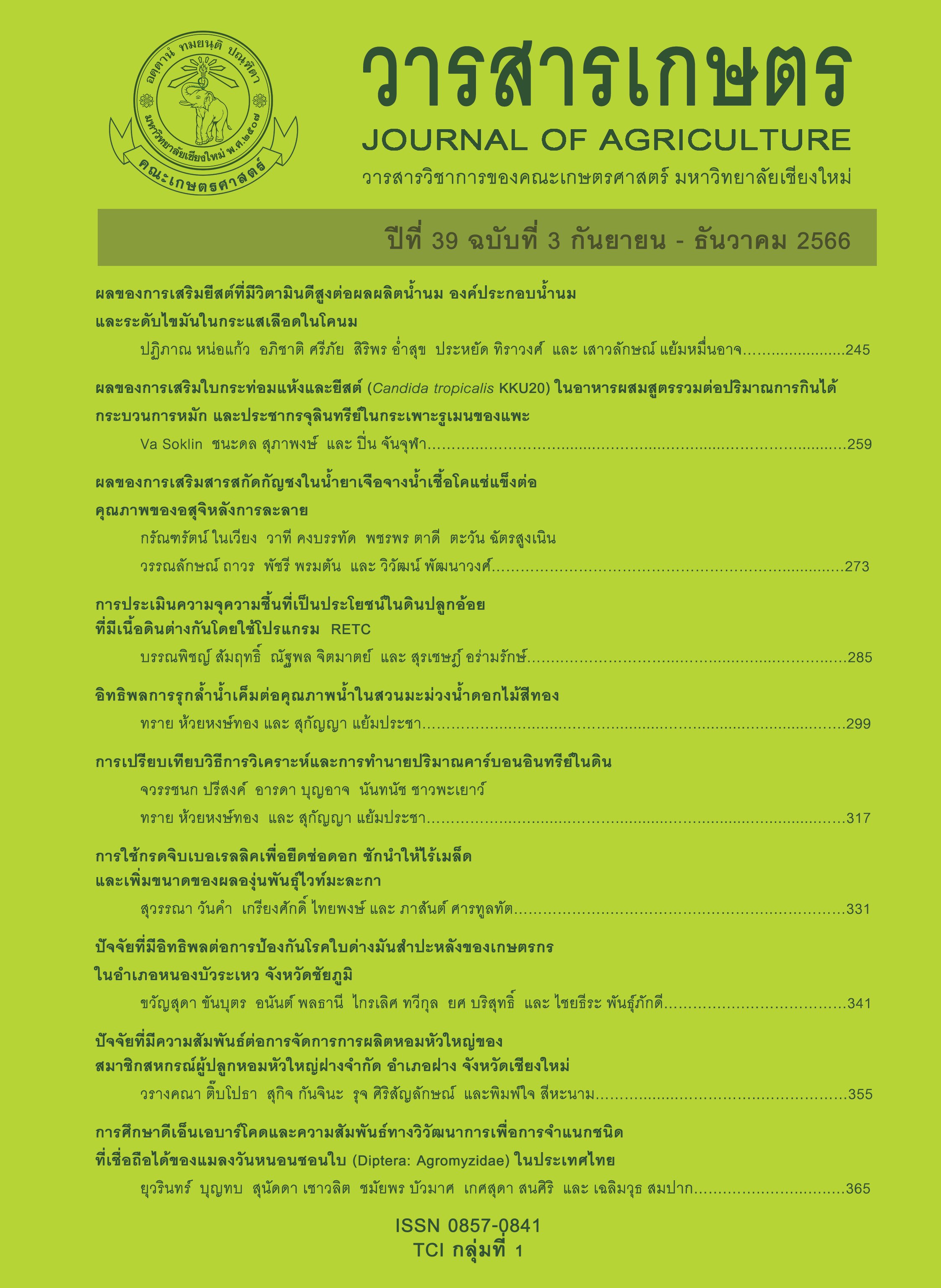การศึกษาดีเอ็นเอบาร์โคดและความสัมพันธ์ทางวิวัฒนาการเพื่อการจำแนกชนิด ที่เชื่อถือได้ของแมลงวันหนอนชอนใบ (Diptera: Agromyzidae) ในประเทศไทย
Main Article Content
บทคัดย่อ
แมลงวันหนอนชอนใบวงศ์ Agromyzidae จัดได้ว่าเป็นกลุ่มศัตรูพืชที่ก่อให้เกิดความสูญเสียทางเศรษฐกิจต่อพืชผักและความท้าทายที่สำคัญยิ่งต่องานด้านการกักกันพืช การศึกษาครั้งนี้ได้ใช้ดีเอ็นเอบาร์โค้ดจากส่วนของยีน cytochrome c oxidase subunit 1 mitochondrial gene (Cox1) มาช่วยในการจำแนกชนิดแมลงวันหนอนชอนใบวงศ์ Agromyzidae ซึ่งเป็นศัตรูพืชผักที่สำคัญในประเทศไทย ลำดับนิวคลีโอไทด์ของแมลงวันหนอนชอนใบได้ถูกรวบรวมภายในประเทศและนำไปวิเคราะห์เพื่อใช้เป็นดีเอ็นเอบาร์โค้ดในการจำแนกชนิดแมลงวันหนอนชอนใบกับลำดับนิวคลีโอไทด์มาตรฐานในฐานข้อมูล GenBank ผลการทดลองพบว่า แมลงวันหนอนชอนใบ Liriomyza sp. จำนวน 5 ชนิด จากลำดับนิวคลีโอไทด์ 20 ตัวอย่าง ถูกระบุและบันทึกไว้ในฐานข้อมูล GenBank ว่าเป็นชนิดพันธุ์ Liriomyza brassicae Riley, 1884; Liriomyza chinensis Kato, 1949; Liriomyza huidobrensis Blanchard, 1926; Liriomyza sativae Blanchard, 1938 และ Liriomyza trifolii Burgess, 1880 การศึกษาความสัมพันธ์ทางวิวัฒนาการ จากลำดับนิวคลีโอไทด์ของตำแหน่งยีน Cox1 จากแมลงวันหนอนชอนใบจำนวน 5 ชนิด มาวิเคราะห์ด้วย Maximum likelihood และ Bayesian analysis พบว่า แผนภูมิความสัมพันธ์ทางวิวัฒนาการจากทั้งสองวิธีการมีผลที่สอดคล้องกันยีน Cox1 แสดงให้เห็นถึงประสิทธิภาพในการใช้จำแนกชนิดแมลงวันหนอนชอนใบ โดยความสัมพันธ์ทางวิวัฒนาการแสดงให้เห็นว่าแมลงวันหนอนชอนใบ L.chinensis นั้น มีความแตกต่างกับแมลงวันหนอนชอนใบชนิดอื่นๆ และยังพบว่า แมลงวันหนอนชอนใบ L. chinensis ที่พบในประเทศไทยนั้นมีความใกล้ชิดทางพันธุกรรมกับชนิดพันธุ์ haplotype A ที่พบในประเทศญี่ปุ่น และแผนภูมิวิวัฒนาการยังแสดงให้เห็นว่า แมลงวันหนอนชอนใบ L. sativae นั้นมีความสัมพันธ์ใกล้ชิดกับแมลงวันหนอนชอนใบ L. trifolii มากกว่าแมลงวันหนอนชอนใบชนิดอื่น ๆ การศึกษานี้ให้ข้อมูลพื้นฐานเกี่ยวกับจำนวนชนิดของแมลงวันหนอนชอนใบสกุล Liriomyza ในประเทศไทย และลำดับนิวคลีโอไทด์ของยีน Cox1 ได้รับการพิสูจน์ว่ามีประสิทธิภาพในการระบุชนิดของแมลงวันหนอนชอนใบ
Article Details

อนุญาตภายใต้เงื่อนไข Creative Commons Attribution-NonCommercial-NoDerivatives 4.0 International License.
เอกสารอ้างอิง
Boontop, Y. 2016. Natural variation and biogeography of the melon fruit fly, Zeugodacus cucurbitae (Diptera: Tephritidae, in Southeast Asia and the West-Pacific. Ph.D. Thesis. Queensland University of Technology, Brisbane, Queensland. 347 p.
Boontop, Y., S. Choavalit, S., C. Buamas and S. Kaewsawat. 2022a. Taxonomy of leafminer flies in family Agromyzidae (Order: Diptera) in vegetable crops. Thai Agricultural Research Journal 40(2): 126-139. (in Thai)
Boontop, Y., S. Chaovalit, C. Buamas, S. Kaewsawat and S. Sathuwijarn. 2022b. Leafminer flies (Diptera: Agromyzidae), their host plants and distribution in Thailand. Entomology and Zoology Gazette 40(1): 2-16. (in Thai)
Carapelli, A., A. Soltani, C. Leo, M. Vitale, M. Amri, and J.M.-B. Jemâa. 2018. Cryptic Diversity Hidden within the Leafminer Genus Liriomyza (Diptera: Agromyzidae). Genes 9(11): 554, doi: 10.3390/genes9110554
Center for Information Technology and Communications. 2022. Principal Export. (Online). Available: https://tradereport.moc.go.th/Tradethai.aspx?chk=0 (December 17, 2022). (in Thai)
Folmer, O., M. Black, W. Hoeh, R. Lutz and R. Vrijenhoek. 1994. DNA primers for amplification of mitochondrial cytochrome c oxidase subunit I from diverse metazoan invertebrates. Molecular Marine Biology and Biotechnology 3(5): 294-299.
Hall, T.A. 1999. BioEdit: A user-friendly biological sequence alignment editor and analysis program for Windows 95/98/NT. Nucleic Acids Symposium Series 41: 95-98.
Nylander, J.A.A., J.C. Wilgenbusch, D.L. Warren and D.L. Swofford. 2008. AWTY (are we there yet?): A system for graphical exploration of MCMC convergence in Bayesian phylogenetics. Bioinformatics 24(4): 581-583.
Parrella, M.P. 1987. Biology of Liriomyza. Annual Review of Entomology 32: 201-224.
Ronquist, F. and J.P. Huelsenbeck. 2003. MrBayes 3: Bayesian phylogenetic inference under mixed models. Bioinformatics 19(12): 1572-1574.
Siripiyasing, P. and A. Chaveerach. 2011. DNA barcode for identification of living species: Case studies of Cytochrome c Oxidase I (COI) in animals. Rajabhat Maha Sarakham University Journal 5(2): 205-210. (in Thai)
Spencer, K.A. and G.C. Steyskal. 1986. Manual of the Agromyzidae (Diptera) of the United States. Agriculture Handbook No. 638. U.S. Department of Agriculture, Washington, D.C. USA. 478 p.
Stamatakis, A. 2014. RAxML version 8: A tool for phylogenetic analysis and post-analysis of large phylogenies. Bioinformatics 30(9): 1312 1313.
Tamura, K., G. Stecher and S. Kumar. 2021. MEGA11: Molecular evolutionary genetics analysis version 11. Molecular Biology and Evolution 38(7): 3022-3027.
Tipphet, K., N. Jaturas and N. Bunchu. 2018. DNA Barcodes for Identification of Medically-Important Insects of Thailand. Thai Science and Technology Journal 26(2): 313-328. (in Thai)
Tokumaru, S., R. Uesugi, C. Urairi, S. Toyoshima, Y. Aoki and A. Iwasaki. 2021. Detection of two biotypes of Liriomyza chinensis (Diptera: Agromyzidae) in Japan. Journal of Economic Entomology 114(3): 1406-1410.
Wang, S., Z. Lei, J. Wen, H. Wang, X. Li, B. Dong and B. Ren. 2014. The complete mitochondrial genome of Liriomyza huidobrensis and comparison with L. trifolii and L. sativae (Diptera: Agromyzidae). Mitochondrial DNA 25(2): 104-105.
Xuan, J.-L., S.J. Scheffer, O. Lonsdale, B.K. Cassel, M.L. Lewis, C.S. Eiseman, W.-X. Liu and B.M. Wiegmann, 2023. A genome-wide phylogeny and the diversification of genus Liriomyza (Diptera: Agromyzidae) inferred from anchored phylogenomics. Systematic Entomology 48(1): 178-197.
Yang, F., Y.Z. Du, L.P. Wang, J.M. Cao and W.W. Yu. 2011. The complete mitochondrial genome of the leafminer Liriomyza sativae (Diptera: Agromyzidae): great difference in the A+T-rich region compared to Liriomyza trifolii. Gene 485(1): 7-15.


